
Below the illusory stability of rising GDP, the extremes of debt, take advantage of, stimulus and speculative craze required to keep the ‘phantom wealth bubble’ from imploding are all rising parabolically.
Picture being at a party celebrating the large wealth produced in the last ten months in stocks, cryptocurrencies, property and almost every other asset class. The lights flicker briefly but the host guarantees the crowd the generator powering the party is working completely.
Being a skeptic, you slip out on the reason of generating more champagne and visit the generator room. To your horror, you find the whole plan held together with duct tape and decayed 2X4s, the electrical panel is an acrid-smelling mess of haphazard frayed wire and the generator is over-heated and vibrating off its foundation bolts. Whatever governor the engine as soon as had is gone, it clearly won’t last the night.
The celebration is the U.S. economy, and the generator room is the Federal Reserve, its proxies and the U.S. Treasury, all going to failure. What we’re experiencing in genuine time is the impression of stability and the inevitability of collapse. I have actually prepared a few charts to brighten this reality graphically.
Here’s the impression of stability in a nutshell: while the broadest step of the economy, gross domestic product (GDP) has actually continued marching greater (in both small and real/inflation-adjusted terms), the quantity of Federal Reserve stimulus and Federal debt needed to keep pressing GDP up at the very same rate has actually taken off higher and is tracking a parabolic blow-off.
Let’s begin with a chart of GDP, which I’ve divided into 4 eras. Age # 1 was the duration of broad-based prosperity, defined as productivity gains that increased wages much faster than inflation, i.e. the purchasing power of wages rose so each hour of labor bought more goods and services. Keep in mind that the GDP was not escalating in this duration, as the gains in productivity and prosperity were real and not based on monetary trickery, debt, take advantage of or Fed stimulus. This period lasted from the 1950s through the mid-1970s, at which point stagflation put an end to the period of rising purchasing power of labor/ earnings.
Age # 2 began around 1981 and lasted until 1999: this was the period of financialization, when financial obligation and utilize replaced productivity as the source of profits and as an outcome speculation, leveraged buy-outs and other monetary gimmicks proved far more successful than in fact producing items and services. A crucial element of financialization is globalization, as the big earnings only flow when debt, danger, income streams and phantom financial instruments can be commoditized (i.e. produced, packaged and offered as commodities) and offered globally.
Age # 3 was the rational extension of financialization and speculation: the U.S. economy ended up being based on debt-asset bubbles for its “growth” and growth of phantom wealth. Bubble # 1, the dot-com speculative frenzy, imploded in 2000, and Bubble # 2, the debt-housing speculative frenzy, imploded in 2008.
Period # 4 is the logical extension of the bubbles popping: an irreversible Fed-fueled speculative frenzy that needs ever greater quantities of Fed stimulus and federal and personal financial obligation, and ever larger extremes of speculative frenzy to avoid imploding.
Here’s nominal GDP: it looks fantastic till we look below the surface.
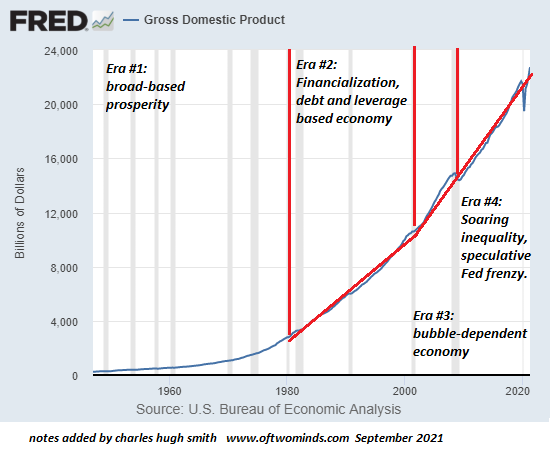
Here’s genuine GDP, changed for main inflation (in chained 2012 dollars ). Looks really comparable to small GDP: if we take a look at the stable climb of genuine GDP, we ‘d picture the nation’s success is even more broad-based and strong than in Era # 1, however we ‘d be incorrect: Periods # 2, # 3 and # 4 are identified by rising inequality, the death-spiral decay of middle class acquiring power and total dependence on increasing stimulus, debt, utilize and speculation.
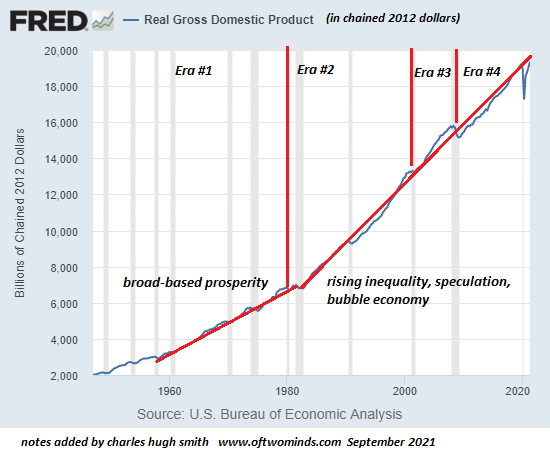
Here’s a glance below the surface: federal debt has actually blown up higher: in Age # 2 (Financialization), federal financial obligation increased from less than $1 trillion in 1981 to $5.7 trillion in 2000– about a 6-fold increase over twenty years. The next twenty years saw federal financial obligation increase from $5.7 trillion to $23.3 trillion in early 2020 (pre-pandemic), and ever since, a sharp ramp to $28.5 trillion.
You see the trend: GDP increased about 7-fold while federal debt rose 30-fold– mainly in the last 13 years of Age # 4.
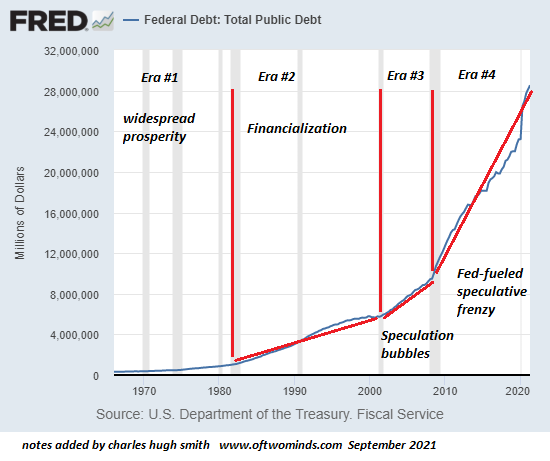
This chart of federal financial obligation as a percentage of GDP is enlightening: notification than in Period # 1(broad-based success ), the percentage declined as GDP grew at a faster rate than federal debt. In Era # 2 (financialization), financial obligation rose far much faster than GDP, but the dot-com boom minimized the portion to around 60%, double the percentage in Age # 1.
Age # 3, the bubble-economy, remained in the exact same range, but the pattern altered in Period # 4, after the Fed’s Bubble # 2 popped, practically bringing down the whole global monetary system. In the age of speculative Fed craze (Period # 4), the debt quickly rose to 100% of GDP and after that made another quantum leap above 120%– a developing-world-kleptocracy level.
While prosperity was replaced by inequality and Fed-inflated speculative bubbles, financial obligation as a portion of GDP rose 4-fold.
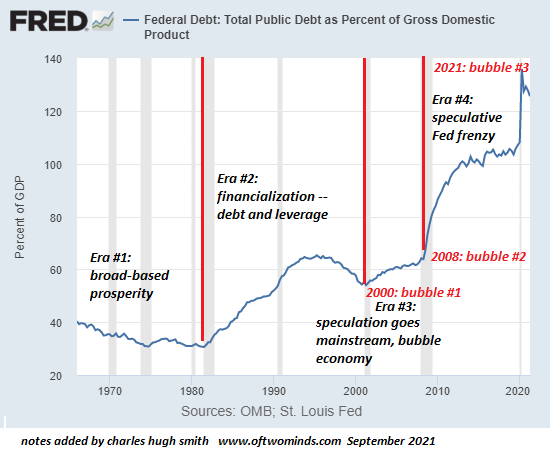
Speaking of parabolic blow-offs, here’s the Federal Reserve balance sheet, up 10-fold in a mere 13 years. Exceptional, isn’t it, that the U.S. economy managed years of growth with the Fed balance sheet far below $1 trillion, decade after years, today the economy needs the Fed to create $7.5 trillion and toss it on the bonfire of speculative bubbles to keep the economy from imploding.
GDP in 2007 was $14.7 trillion and the Fed balance sheet was $800 billion, or 5.4% of GDP. Now the Fed balance sheet is over 36% of GDP, about a 7-fold increase in a mere 13 years. Notification the rate of expansion is near-parabolic, even as GDP has actually recovered to pre-pandemic levels.
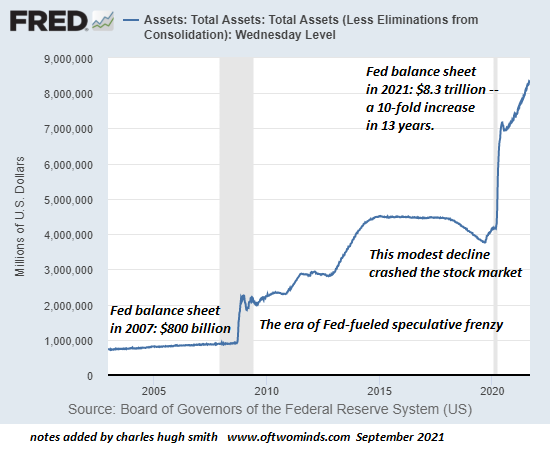
Other reserve banks followed this very same growth of financial stimulus. If GDP has normalized, then why the continuing panic-expansion of financial stimulus? The only logical explanation is the system was breaking down before the pandemic and its decay has sped up.
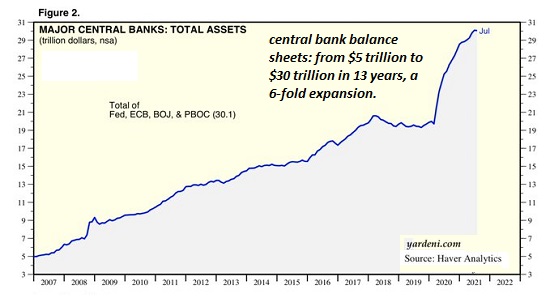
We all know what happens when the expansion of financial obligation, take advantage of, speculation and central bank stimulus fail by even the tiniest bit: the entire worldwide phantom wealth bubble pops: this shows up in the chart of overall financial obligation, public and personal:
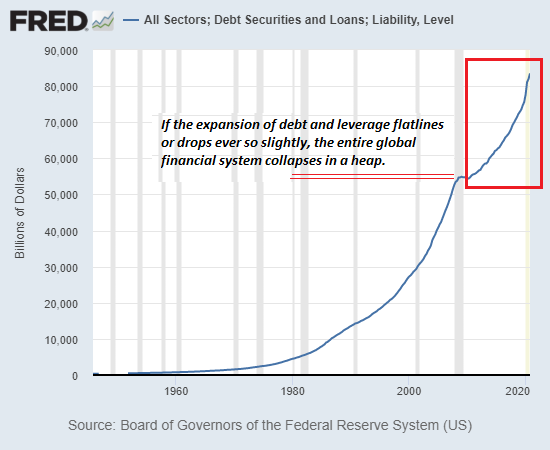
Beneath the illusory stability of rising GDP, the extremes of debt, utilize, stimulus and speculative frenzy needed to keep the phantom wealth bubble from imploding are all increasing parabolically. Every effort to return to an economy that’s not dependent on debt-asset bubbles and unsustainable expansions of debt and monetary stimulus has actually triggered a worldwide market crash which can only be conserved by doubling, tripling or quadrupling the previous levels of financial obligation and stimulus.
This is why collapse is now inevitable. Parabolic blow-off expansions produce instabilities that can not be reduced by doing more of what’s stopping working; that is called go to failure for a reason: the only possible result is systemic failure, i.e. the collapse of the phantom wealth bubble, a collapse which will reduce the entire machinery of bubble-blowing.
Before you pop that bottle of champagne, you much better check out the generator room initially. Duct tape, torn wiring, the scent of overheated metal and decomposed 2X4s are not going to keep the celebration lights going a lot longer.
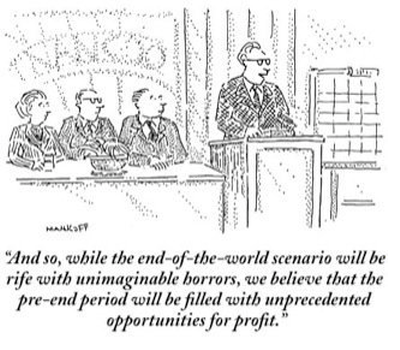
If you discovered value in this content, please join me in seeking options by becoming a $1/month customer of my work by means of patreon.com.
My new book is offered! A Hacker’s Teleology: Sharing the Wealth of Our Diminishing World 20% and 15% discount rates (Kindle $7, print $17, audiobook now available $17.46)
Read excerpts of the book totally free (PDF).
The Story Behind the Book and the Intro.
Recent Videos/Podcasts:
Charles Hugh Smith on Secular Inflation (Host Richard Bonugli, 31 minutes)
My recent books:
A Hacker’s Teleology: Sharing the Wealth of Our Shrinking World (Kindle $8.95, print $20, audiobook $17.46) Read the first section for free (PDF).
Will You Be Richer or Poorer?: Earnings, Power, and AI in a Distressed World
(Kindle $5, print $10, audiobook) Check out the first area free of charge (PDF).
Pathfinding our Fate: Preventing the Final Fall of Our Democratic Republic ($5 (Kindle), $10 (print), ( audiobook): Read the first section free of charge (PDF).
The Adventures of the Consulting Theorist: The Disappearance of Drake $1.29 (Kindle), $8.95 (print); read the first chapters for free (PDF)
Money and Work Unchained $6.95 (Kindle), $15 (print) Read the very first area for free (PDF).
Become a $1/month customer of my work by means of patreon.com.
KEEP IN MIND: Contributions/subscriptions are acknowledged in the order got. Your name and e-mail stay personal and will not be provided to any other private, business or firm.
|
Thank you, J. Timothy B. ($100), for your outrageously generous contribution to this website– I am considerably honored by your unfaltering support and readership. |
Thank you |
, A.S.L. ($100), for your insanely generous contribution to this site– I am significantly honored by your unfaltering assistance and readership. |
|
Thank you, Man T. ($50), for your superbly generous contribution to this site– I am greatly honored by your unfaltering support and readership. |
Thank you |
, David E. ($60), for your splendidly generous contribution to this site– I am significantly honored by your unfaltering support and readership. |

